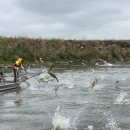Species that are considered high risk have a well-documented history of invasiveness in at least one location globally, and a high or medium climate match to the contiguous United States.
Sinanodonta woodiana, the Chinese Pond Mussel, is a large freshwater mussel native to Eastern Asia, primarily from Amur and Yangtze rivers in Russia and China. This species has been introduced and become established in many countries around the world, in southern Asia, Europe, and North America. S. woodiana most likely arrived as glochidia (larvae) attached to the gills of imported Asian carp. S. woodiana can impact native mussels and other benthic invertebrates as competitors for food, space and hosts. Donrovich et al. (2017) found that S. woodiana can decrease metamorphosis of native mussels due to cross-resistance. The history of invasiveness of this species is classified as High. The overall climate match for the contiguous United States is High, with nearly all States having high individual Climate 6 scores. The certainty of assessment is High. Therefore, the overall risk assessment category for S. woodiana is High.



